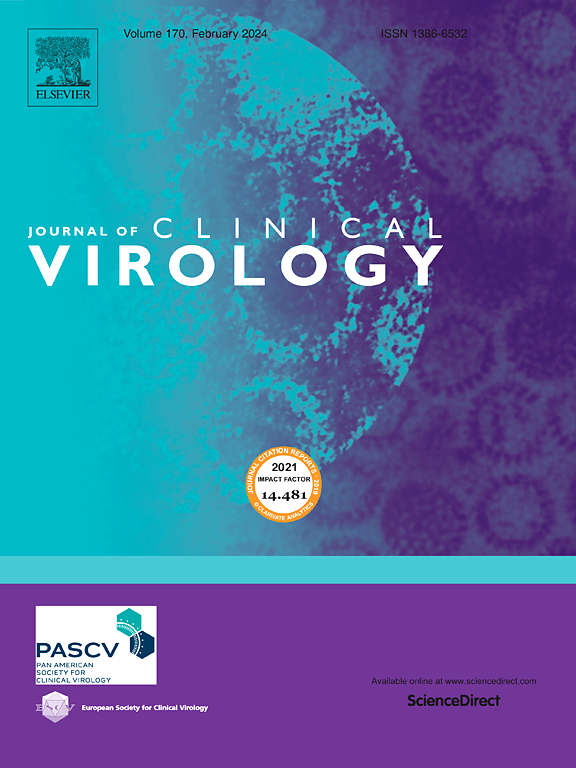乙型肝炎病毒(HBV)携带者在接受含富马酸替诺福韦二吡呋酯的抗逆转录病毒治疗后仍出现病毒血症
IF 3.4
3区 医学
Q2 VIROLOGY
引用次数: 0
摘要
背景治疗乙型肝炎病毒(HBV)和人类免疫缺陷病毒(HIV)合并感染的目标是抑制这两种病毒;然而,在基于替诺福韦(TFV)富马酸二吡呋酯(TDF)的抗逆转录病毒疗法(ART)中,HBV抑制不完全的情况很常见。本研究调查了在使用含 TDF/lamivudine (3TC) 的抗逆转录病毒疗法时出现病毒血症的 HBV/HIV 合并感染者的 TFV 耐药性相关突变 (RAM)。为进行 RAM 分析,对 HBV 进行了测序。外周血单核细胞(PBMCs)中的TFV-二磷酸(TFV-DP)浓度用于评估抗逆转录病毒疗法的依从性水平。结果138名参与者中有9人(6.5%)在接受抗逆转录病毒疗法期间检测到HBV DNA水平≥20 IU/mL。9 名参与者中有 7 人的 TFV-DP 浓度与每周 7 次服药相称,6 人的 HIV RNA 得到抑制。系统发育分析表明,8 个序列为 HBV 基因 E 型,其中 1 个为基因 E/A 重组型。研究样本中出现了 10 个以前报告过的 TFV RAM,其中 8 个是 HBV 基因型 E 的野生型。结论 尽管高度坚持以 TDF/3TC 为基础的抗逆转录病毒疗法,但 HBV 病毒血症可能与 TFV RAM 的存在有关。这些发现凸显了加强耐药性监测和进一步研究的必要性,以检查报告的 TFV RAMs 的临床意义。HBV/HIV合并感染者在使用TDF抗逆转录病毒疗法时出现TFV耐药,可能需要采取其他治疗策略。本文章由计算机程序翻译,如有差异,请以英文原文为准。
Hepatitis B virus (HBV) viremia despite tenofovir disoproxil fumarate-containing antiretroviral therapy in persons with HBV/HIV coinfection
Background
The goal of treatment of hepatitis B virus (HBV) and human immunodeficiency virus (HIV) coinfection is suppression of both viruses; yet incomplete HBV suppression on tenofovir (TFV) disoproxil fumarate (TDF)-based antiretroviral therapy (ART) is common. This study investigated TFV resistance-associated mutations (RAMs) in individuals with HBV/HIV coinfection with viremia on TDF/lamivudine (3TC)-containing ART.
Methods
Samples from individuals with HBV DNA levels ≥20 IU/mL in a cross-sectional study of 138 persons with HBV/HIV coinfection in Ghana were analyzed in the present study. HBV was sequenced for RAM analysis. TFV-diphosphate (TFV-DP) concentration in peripheral blood mononuclear cells (PBMCs) was used to assess ART adherence level.
Results
Nine of 138 participants (6.5 %) had detectable HBV DNA levels ≥20 IU/mL while on ART. Seven of the nine participants had TFV-DP concentrations commensurate with 7 doses per week, and six had suppressed HIV RNA. Phylogenetic analysis revealed that eight sequences were HBV genotype E, with one genotype E/A recombinant. Ten previously-reported TFV RAMs were present in the study samples; eight were wild-type for HBV genotype E. The non-genotype-E-wild-type point mutations M267L and K333Q were found in two and one patients, respectively. No 3TC RAMs were found.
Conclusion
HBV viremia despite high adherence to TDF/3TC-based ART may be associated with the presence of TFV RAMs. These findings highlight the need for enhanced resistance monitoring and further research to examine the clinical significance of reported TFV RAMs. Individuals with HBV/HIV coinfection and TFV resistance on TDF-based ART may need alternative treatment strategies.
求助全文
通过发布文献求助,成功后即可免费获取论文全文。
去求助
来源期刊

Journal of Clinical Virology
医学-病毒学
CiteScore
22.70
自引率
1.10%
发文量
149
审稿时长
24 days
期刊介绍:
The Journal of Clinical Virology, an esteemed international publication, serves as the official journal for both the Pan American Society for Clinical Virology and The European Society for Clinical Virology. Dedicated to advancing the understanding of human virology in clinical settings, the Journal of Clinical Virology focuses on disseminating research papers and reviews pertaining to the clinical aspects of virology. Its scope encompasses articles discussing diagnostic methodologies and virus-induced clinical conditions, with an emphasis on practicality and relevance to clinical practice.
The journal publishes on topics that include:
• new diagnostic technologies
• nucleic acid amplification and serologic testing
• targeted and metagenomic next-generation sequencing
• emerging pandemic viral threats
• respiratory viruses
• transplant viruses
• chronic viral infections
• cancer-associated viruses
• gastrointestinal viruses
• central nervous system viruses
• one health (excludes animal health)
 求助内容:
求助内容: 应助结果提醒方式:
应助结果提醒方式:


